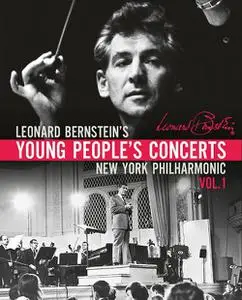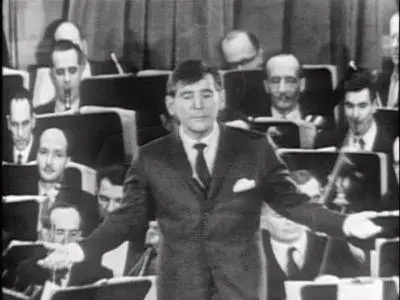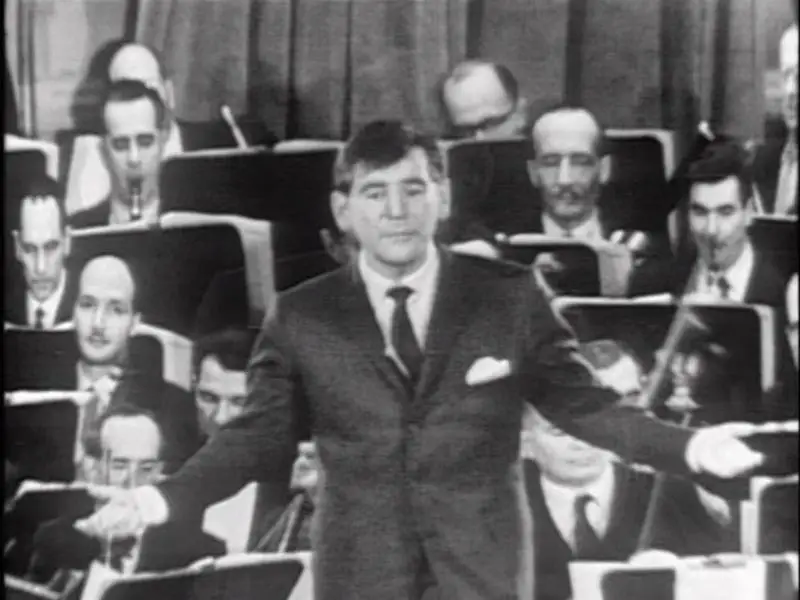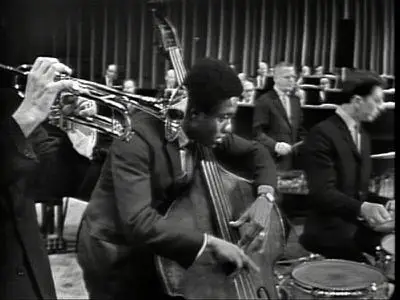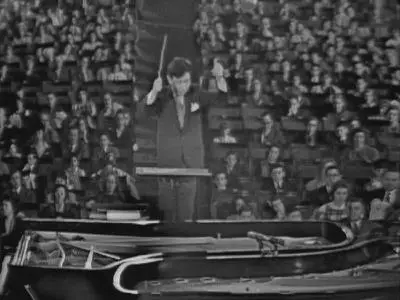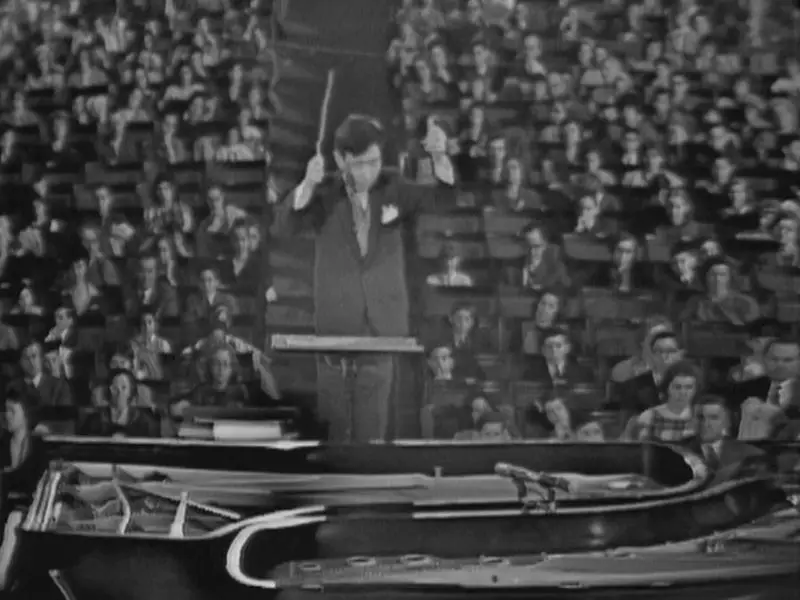CBS - Young People's Concerts - Volume 1 (1958)
BDRip | 1440 x 1080 | .MKV/HEVC @ 2212 Kbps | 17x~59mn | 17.6 GB
Audio: English AAC 265 Kbps, 2 channels | Subs: English, Deutsch, Italiano, 한국어, 日本語
Genre: Documentary, Travel
BDRip | 1440 x 1080 | .MKV/HEVC @ 2212 Kbps | 17x~59mn | 17.6 GB
Audio: English AAC 265 Kbps, 2 channels | Subs: English, Deutsch, Italiano, 한국어, 日本語
Genre: Documentary, Travel
Awarded three Emmys and hailed by Variety as "a rare moment in the symbiosis of the arts and broadcasting", Leonard Bernstein's?Young People's Concerts?left their mark on television history. Aired at prime-time on CBS from 1958 to 1972, 52 one-hour programs were written and hosted by Leonard Bernstein, "certainly the most influential American maestro of the 20th century" (The New York Times). With the New York Philharmonic and guest artists providing live music, these programs brought musical concepts and music history to life for generations of viewers.
Part 1: What Does Music Mean
Leonard Bernstein told the television audience at the start of the first Young People's Concert: "No matter what stories people tell you about what music means, forget them. Stories are not what music means. Music is never about things. Music just is. It's a lot of beautiful notes and sounds put together so well that we get pleasure out of hearing them. So when we ask What does it mean, what does this piece of music mean?' we're asking a hard question. Let's do our best to answer it." During the course of the first program, the New York Philharmonic performs portions of Rossini's William Tell overture, Beethoven's Sixth Symphony and Ravel's La Valse.
Part 2: What is American Music
From Carnegie Hall, Bernstein discusses the origins and characteristics of American music. After an extended excerpt from George Gershwin's An American in Paris and a discussion of nationalistic and folk music, excerpts from compositions by American composers Edward MacDowell, William Schuman, Virgil Thomson and others are performed. In closing, Aaron Copland conducts part of his own Third Symphony.
Part 3: What Does Orchestration Mean
After brief introductory remarks, Bernstein conducts the finale of Rimsky-Korsakov's Capriccio Espagnol and then explains what a composer must know in order to orchestrate music successfully. He compares the flute to the trumpet, and the clarinet to the viola, with examples from Debussy and Gershwin. After asking the audience to sing two notes in a variety of ways, he contrasts the families of instruments that compose an orchestra, using excerpts from Prokofiev, Hindemith, Mozart and others to illustrate, ending with Ravel's Bolero.
Part 4: What Makes Music Symphonic
Using the examples of Mozart's Jupiter Symphony and Tchaikovsky's Fourth Symphony, Bernstein demonstrates the techniques of repetition and variation in the development of symphonic music. After conducting part of Tchaikovsky's Romeo and Juliet asks the audience to sing Fr?re Jacques, demonstrating the uses of sequencing and imitation in symphonic composition. The final movement of Brahms's Second Symphony is then analyzed and played.
Part 5: What is Classical Music
Bernstein conducts Handel's Water Music and cites it as an indisputable example of classical music. "Exact" is the word that best defines classical music, Bernstein says, and he demonstrates it with musical illustrations from Bach's Fourth Brandenburg Concerto, Mozart's Piano Concerto No. 21 and The Marriage of Figaro, and Haydn's Symphony No. 102. The decline in classical music at the end of the 18th century is tied to Beethoven and the Romantic movement, and Bernstein conducts Beethoven' Egmont overture.
Part 6: Humor in Music
Using excerpts from Shostakovich, Mahler, Haydn and others, Bernstein demonstrates how a "serious" composition can take an unexpectedly humorous turn. Prokofiev's Classical Symphony is played in its entirety.
Part 7: What is a Concerto
Leonard Bernstein discusses the development of the concerto form from Bach to Bart?k. Bernstein conducts examples of early concertos Bach's Fifth Brandenburg Concerto and Vivaldi's Concerto in C major. From the classical period, he conducts Mozart's Sinfonia Concertante and, finally, the fourth and fifth movements of Bart?k's neoclassical Concerto for Orchestra.
Part 8: Who is Gustav Mahler
Leonard Bernstein celebrates Mahler's centennial by conducting excerpts from the composer's Fourth Symphony and discussing his career as a composer and conductor. Soprano Reri Grist joins the orchestra in a performance of the last movement of the Fourth Symphony. William Lewis sings "Youth" and Helen Raab sings from "The Farewell, both from Mahler's The Song of the Earth.
Part 9: Folk Music in the Concert Hall
Bernstein discusses folk music and its influence on orchestral music, and conducts excerpts from Mozart, Chavez and lves, and Songs of the Auvergne sung by Marni Nixon.
Part 10: What is Impressionism
Bernstein focuses on Impressionism in music, discussing the methods and styles of Debussy and Ravel. He conducts three movements from La Mer and the final dance of Daphnis et Chloe.
Part 11: Happy Birthday Igor Stravinsky
Bernstein sketches a brief history of Stravinsky's musical career, noting changes of style and shifts of direction. The whole of Petrouchka is played and each scene is analyzed.
Part 12: What is a Melody
Bernstein discusses the different forms melody can take, including tune, theme, motive, melodic line and musical phrase. He illustrates by conducting the orchestra in excerpts from Tchaikovsky, Wagner, Mozart, Hindemith and Brahms.
Part 13: The Latin American Spirit
Bernstein discusses "the two ingredients that give music its special Latin flavor: rhythm and color". Excerpts include Bernstein's own symphonic dances from West Side Story.
Part 14: Jazz in the Concert Hall
Bernstein discusses the blending of jazz and symphonic music, with performances and readings to illustrate. The program ends with Larry Austin's Improvisations for Orchestra and Jazz Soloists.
Part 15: Young Performers No 1
Leonard Bernstein introduces young conductors and performers. Cellist Daniel Domb plays the Dvor?k Cello Concerto in B Minor, conducted by Kenneth Schermerhorn, and Stefan Mengelberg conducts the final movement of the Wieniawski Violin Concerto in D Minor, with Barry Finclair on violin. Finally, Leonard Bernstein conducts Prokofiev's Peter and the Wolf with nine-year-old Alexandra Wager narrating.
Part 16: Young Performers No 2
Leonard Bernstein presents the annual Young People's Concert devoted to young performers, including: cellist Lynn Harrell and conductor Elyakum Shapira playing music by Dvor?k; pianist Jung Ja Kim and conductor Russell Stager with music by Chopin; soprano Veronica Tyler and conductor Gregory Millar with an aria from Puccinis La Boh?me; and Bernstein conducting and Henry Chapin narrating The Young Person's Guide to the Orchestra by Britten.
Part 17: Young Performers No 3
Leonard Bernstein presents Seiji Ozawa, who conducts the overture to The Marriage of Figaro by Mozart. Also on this program, Maurice Peress and John Canaria conduct compositions featuring Gary Karr on double bass, and Bernstein discusses and conducts The Carnival of the Animals by Camille Saint-Sa?ns. Featured are guest soloists Ruth and Naomi Segal (piano duo), Tony Cirone (xylophone), David Hopper (glockenspiel), Paula Robison (flute), and Paul Green (clarinet).
General
Unique ID : 12005653879148349581827281413824934999 (0x908346FCA3D908FEA77898462657457)
Complete name : CBS.Leonard.Bernstein.Young.Peoples.Concerts.Vol.1.01of17.What.Does.Music.Mean..mkv
Format : Matroska
Format version : Version 4 / Version 2
File size : 1.05 GiB
Duration : 59 min 6 s
Overall bit rate : 2 533 kb/s
Movie name : Leonard Bernstein's Young People's Concerts Vol. 1 Episode 01 What is Music?
Encoded date : UTC 2022-07-24 17:11:20
Writing application : mkvmerge v69.0.0 ('Day And Age') 64-bit
Writing library : libebml v1.4.2 + libmatroska v1.6.4 / Lavf59.29.100
Comment : Broadcast date: 1958-01-18
Video
ID : 1
ID in the original source medium : 4113 (0x1011)
Format : HEVC
Format/Info : High Efficiency Video Coding
Format profile : Main@L4@Main
Codec ID : V_MPEGH/ISO/HEVC
Duration : 59 min 6 s
Bit rate : 2 212 kb/s
Width : 1 440 pixels
Height : 1 080 pixels
Display aspect ratio : 4:3
Frame rate mode : Constant
Frame rate : 29.970 (30000/1001) FPS
Color space : YUV
Chroma subsampling : 4:2:0 (Type 0)
Bit depth : 8 bits
Bits/(Pixel*Frame) : 0.047
Stream size : 935 MiB (87%)
Writing library : x265 3.5+39-8424d9190:[Windows][GCC 12.1.0][64 bit] 8bit+10bit+12bit
Encoding settings : cpuid=1111039 / frame-threads=3 / numa-pools=12 / wpp / no-pmode / no-pme / no-psnr / no-ssim / log-level=2 / input-csp=1 / input-res=1440x1080 / interlace=0 / total-frames=0 / level-idc=0 / high-tier=1 / uhd-bd=0 / ref=3 / no-allow-non-conformance / no-repeat-headers / annexb / no-aud / no-eob / no-eos / no-hrd / info / hash=0 / no-temporal-layers / no-open-gop / min-keyint=29 / keyint=300 / gop-lookahead=12 / bframes=6 / b-adapt=2 / b-pyramid / bframe-bias=0 / rc-lookahead=20 / lookahead-slices=6 / scenecut=40 / no-hist-scenecut / radl=0 / no-splice / no-intra-refresh / ctu=64 / min-cu-size=8 / no-rect / no-amp / max-tu-size=32 / tu-inter-depth=1 / tu-intra-depth=1 / limit-tu=0 / rdoq-level=0 / dynamic-rd=0.00 / no-ssim-rd / signhide / no-tskip / nr-intra=0 / nr-inter=0 / no-constrained-intra / no-strong-intra-smoothing / max-merge=3 / limit-refs=1 / no-limit-modes / me=2 / subme=2 / merange=48 / temporal-mvp / no-frame-dup / hme / Level / merange / L0,L1,L2=16,32,48 / weightp / weightb / no-analyze-src-pics / deblock=0:0 / sao / no-sao-non-deblock / rd=3 / selective-sao=4 / early-skip / rskip / no-fast-intra / no-tskip-fast / no-cu-lossless / b-intra / no-splitrd-skip / rdpenalty=0 / psy-rd=2.00 / psy-rdoq=0.00 / no-rd-refine / no-lossless / cbqpoffs=0 / crqpoffs=0 / rc=crf / crf=21.0 / qcomp=0.60 / qpstep=4 / stats-write=0 / stats-read=0 / ipratio=1.40 / pbratio=1.30 / aq-mode=4 / aq-strength=1.00 / cutree / zone-count=0 / no-strict-cbr / qg-size=32 / no-rc-grain / qpmax=69 / qpmin=0 / no-const-vbv / sar=1 / overscan=0 / videoformat=5 / range=0 / colorprim=1 / transfer=1 / colormatrix=1 / chromaloc=1 / chromaloc-top=0 / chromaloc-bottom=0 / display-window=0 / cll=0,0 / min-luma=0 / max-luma=255 / log2-max-poc-lsb=8 / vui-timing-info / vui-hrd-info / slices=1 / no-opt-qp-pps / no-opt-ref-list-length-pps / no-multi-pass-opt-rps / scenecut-bias=0.05 / hist-threshold=0.03 / no-opt-cu-delta-qp / no-aq-motion / no-hdr10 / no-hdr10-opt / no-dhdr10-opt / no-idr-recovery-sei / analysis-reuse-level=0 / analysis-save-reuse-level=0 / analysis-load-reuse-level=0 / scale-factor=0 / refine-intra=0 / refine-inter=0 / refine-mv=1 / refine-ctu-distortion=0 / no-limit-sao / ctu-info=0 / no-lowpass-dct / refine-analysis-type=0 / copy-pic=1 / max-ausize-factor=1.0 / no-dynamic-refine / no-single-sei / no-hevc-aq / no-svt / no-field / qp-adaptation-range=1.00 / scenecut-aware-qp=0conformance-window-offsets / right=0 / bottom=0 / decoder-max-rate=0 / no-vbv-live-multi-pass
Language : English
Default : No
Forced : No
Color range : Limited
Color primaries : BT.709
Transfer characteristics : BT.709
Matrix coefficients : BT.709
Original source medium : Blu-ray
Audio
ID : 2
Format : AAC
Format/Info : Advanced Audio Codec
Format profile : LC
Codec ID : A_AAC-2
Duration : 59 min 6 s
Bit rate : 265 kb/s
Channel(s) : 2 channels
Channel positions : Front: L R
Sampling rate : 48.0 kHz
Frame rate : 46.875 FPS (1024 SPF)
Compression mode : Lossy
Stream size : 111 MiB (10%)
Language : English
Default : Yes
Forced : No
Text #1
ID : 3
ID in the original source medium : 4608 (0x1200)
Format : PGS
Muxing mode : zlib
Codec ID : S_HDMV/PGS
Codec ID/Info : Picture based subtitle format used on BDs/HD-DVDs
Duration : 48 min 46 s
Bit rate : 37.8 kb/s
Count of elements : 1288
Stream size : 13.2 MiB (1%)
Language : English
Default : No
Forced : No
Original source medium : Blu-ray
Text #2
ID : 4
ID in the original source medium : 4609 (0x1201)
Format : PGS
Muxing mode : zlib
Codec ID : S_HDMV/PGS
Codec ID/Info : Picture based subtitle format used on BDs/HD-DVDs
Duration : 48 min 55 s
Bit rate : 26.8 kb/s
Count of elements : 842
Stream size : 9.37 MiB (1%)
Language : German
Default : No
Forced : No
Original source medium : Blu-ray
Text #3
ID : 5
ID in the original source medium : 4610 (0x1202)
Format : PGS
Muxing mode : zlib
Codec ID : S_HDMV/PGS
Codec ID/Info : Picture based subtitle format used on BDs/HD-DVDs
Duration : 48 min 56 s
Bit rate : 31.1 kb/s
Count of elements : 912
Stream size : 10.9 MiB (1%)
Language : Italian
Default : No
Forced : No
Original source medium : Blu-ray
Text #4
ID : 6
ID in the original source medium : 4611 (0x1203)
Format : PGS
Muxing mode : zlib
Codec ID : S_HDMV/PGS
Codec ID/Info : Picture based subtitle format used on BDs/HD-DVDs
Duration : 58 min 28 s
Bit rate : 23.4 kb/s
Count of elements : 1028
Stream size : 9.78 MiB (1%)
Language : Korean
Default : No
Forced : No
Original source medium : Blu-ray
Text #5
ID : 7
ID in the original source medium : 4612 (0x1204)
Format : PGS
Muxing mode : zlib
Codec ID : S_HDMV/PGS
Codec ID/Info : Picture based subtitle format used on BDs/HD-DVDs
Duration : 48 min 46 s
Bit rate : 32.2 kb/s
Count of elements : 1288
Stream size : 11.2 MiB (1%)
Language : Japanese
Default : No
Forced : No
Original source medium : Blu-ray
Unique ID : 12005653879148349581827281413824934999 (0x908346FCA3D908FEA77898462657457)
Complete name : CBS.Leonard.Bernstein.Young.Peoples.Concerts.Vol.1.01of17.What.Does.Music.Mean..mkv
Format : Matroska
Format version : Version 4 / Version 2
File size : 1.05 GiB
Duration : 59 min 6 s
Overall bit rate : 2 533 kb/s
Movie name : Leonard Bernstein's Young People's Concerts Vol. 1 Episode 01 What is Music?
Encoded date : UTC 2022-07-24 17:11:20
Writing application : mkvmerge v69.0.0 ('Day And Age') 64-bit
Writing library : libebml v1.4.2 + libmatroska v1.6.4 / Lavf59.29.100
Comment : Broadcast date: 1958-01-18
Video
ID : 1
ID in the original source medium : 4113 (0x1011)
Format : HEVC
Format/Info : High Efficiency Video Coding
Format profile : Main@L4@Main
Codec ID : V_MPEGH/ISO/HEVC
Duration : 59 min 6 s
Bit rate : 2 212 kb/s
Width : 1 440 pixels
Height : 1 080 pixels
Display aspect ratio : 4:3
Frame rate mode : Constant
Frame rate : 29.970 (30000/1001) FPS
Color space : YUV
Chroma subsampling : 4:2:0 (Type 0)
Bit depth : 8 bits
Bits/(Pixel*Frame) : 0.047
Stream size : 935 MiB (87%)
Writing library : x265 3.5+39-8424d9190:[Windows][GCC 12.1.0][64 bit] 8bit+10bit+12bit
Encoding settings : cpuid=1111039 / frame-threads=3 / numa-pools=12 / wpp / no-pmode / no-pme / no-psnr / no-ssim / log-level=2 / input-csp=1 / input-res=1440x1080 / interlace=0 / total-frames=0 / level-idc=0 / high-tier=1 / uhd-bd=0 / ref=3 / no-allow-non-conformance / no-repeat-headers / annexb / no-aud / no-eob / no-eos / no-hrd / info / hash=0 / no-temporal-layers / no-open-gop / min-keyint=29 / keyint=300 / gop-lookahead=12 / bframes=6 / b-adapt=2 / b-pyramid / bframe-bias=0 / rc-lookahead=20 / lookahead-slices=6 / scenecut=40 / no-hist-scenecut / radl=0 / no-splice / no-intra-refresh / ctu=64 / min-cu-size=8 / no-rect / no-amp / max-tu-size=32 / tu-inter-depth=1 / tu-intra-depth=1 / limit-tu=0 / rdoq-level=0 / dynamic-rd=0.00 / no-ssim-rd / signhide / no-tskip / nr-intra=0 / nr-inter=0 / no-constrained-intra / no-strong-intra-smoothing / max-merge=3 / limit-refs=1 / no-limit-modes / me=2 / subme=2 / merange=48 / temporal-mvp / no-frame-dup / hme / Level / merange / L0,L1,L2=16,32,48 / weightp / weightb / no-analyze-src-pics / deblock=0:0 / sao / no-sao-non-deblock / rd=3 / selective-sao=4 / early-skip / rskip / no-fast-intra / no-tskip-fast / no-cu-lossless / b-intra / no-splitrd-skip / rdpenalty=0 / psy-rd=2.00 / psy-rdoq=0.00 / no-rd-refine / no-lossless / cbqpoffs=0 / crqpoffs=0 / rc=crf / crf=21.0 / qcomp=0.60 / qpstep=4 / stats-write=0 / stats-read=0 / ipratio=1.40 / pbratio=1.30 / aq-mode=4 / aq-strength=1.00 / cutree / zone-count=0 / no-strict-cbr / qg-size=32 / no-rc-grain / qpmax=69 / qpmin=0 / no-const-vbv / sar=1 / overscan=0 / videoformat=5 / range=0 / colorprim=1 / transfer=1 / colormatrix=1 / chromaloc=1 / chromaloc-top=0 / chromaloc-bottom=0 / display-window=0 / cll=0,0 / min-luma=0 / max-luma=255 / log2-max-poc-lsb=8 / vui-timing-info / vui-hrd-info / slices=1 / no-opt-qp-pps / no-opt-ref-list-length-pps / no-multi-pass-opt-rps / scenecut-bias=0.05 / hist-threshold=0.03 / no-opt-cu-delta-qp / no-aq-motion / no-hdr10 / no-hdr10-opt / no-dhdr10-opt / no-idr-recovery-sei / analysis-reuse-level=0 / analysis-save-reuse-level=0 / analysis-load-reuse-level=0 / scale-factor=0 / refine-intra=0 / refine-inter=0 / refine-mv=1 / refine-ctu-distortion=0 / no-limit-sao / ctu-info=0 / no-lowpass-dct / refine-analysis-type=0 / copy-pic=1 / max-ausize-factor=1.0 / no-dynamic-refine / no-single-sei / no-hevc-aq / no-svt / no-field / qp-adaptation-range=1.00 / scenecut-aware-qp=0conformance-window-offsets / right=0 / bottom=0 / decoder-max-rate=0 / no-vbv-live-multi-pass
Language : English
Default : No
Forced : No
Color range : Limited
Color primaries : BT.709
Transfer characteristics : BT.709
Matrix coefficients : BT.709
Original source medium : Blu-ray
Audio
ID : 2
Format : AAC
Format/Info : Advanced Audio Codec
Format profile : LC
Codec ID : A_AAC-2
Duration : 59 min 6 s
Bit rate : 265 kb/s
Channel(s) : 2 channels
Channel positions : Front: L R
Sampling rate : 48.0 kHz
Frame rate : 46.875 FPS (1024 SPF)
Compression mode : Lossy
Stream size : 111 MiB (10%)
Language : English
Default : Yes
Forced : No
Text #1
ID : 3
ID in the original source medium : 4608 (0x1200)
Format : PGS
Muxing mode : zlib
Codec ID : S_HDMV/PGS
Codec ID/Info : Picture based subtitle format used on BDs/HD-DVDs
Duration : 48 min 46 s
Bit rate : 37.8 kb/s
Count of elements : 1288
Stream size : 13.2 MiB (1%)
Language : English
Default : No
Forced : No
Original source medium : Blu-ray
Text #2
ID : 4
ID in the original source medium : 4609 (0x1201)
Format : PGS
Muxing mode : zlib
Codec ID : S_HDMV/PGS
Codec ID/Info : Picture based subtitle format used on BDs/HD-DVDs
Duration : 48 min 55 s
Bit rate : 26.8 kb/s
Count of elements : 842
Stream size : 9.37 MiB (1%)
Language : German
Default : No
Forced : No
Original source medium : Blu-ray
Text #3
ID : 5
ID in the original source medium : 4610 (0x1202)
Format : PGS
Muxing mode : zlib
Codec ID : S_HDMV/PGS
Codec ID/Info : Picture based subtitle format used on BDs/HD-DVDs
Duration : 48 min 56 s
Bit rate : 31.1 kb/s
Count of elements : 912
Stream size : 10.9 MiB (1%)
Language : Italian
Default : No
Forced : No
Original source medium : Blu-ray
Text #4
ID : 6
ID in the original source medium : 4611 (0x1203)
Format : PGS
Muxing mode : zlib
Codec ID : S_HDMV/PGS
Codec ID/Info : Picture based subtitle format used on BDs/HD-DVDs
Duration : 58 min 28 s
Bit rate : 23.4 kb/s
Count of elements : 1028
Stream size : 9.78 MiB (1%)
Language : Korean
Default : No
Forced : No
Original source medium : Blu-ray
Text #5
ID : 7
ID in the original source medium : 4612 (0x1204)
Format : PGS
Muxing mode : zlib
Codec ID : S_HDMV/PGS
Codec ID/Info : Picture based subtitle format used on BDs/HD-DVDs
Duration : 48 min 46 s
Bit rate : 32.2 kb/s
Count of elements : 1288
Stream size : 11.2 MiB (1%)
Language : Japanese
Default : No
Forced : No
Original source medium : Blu-ray
Screenshots
Welcome to my blog - daily update!


